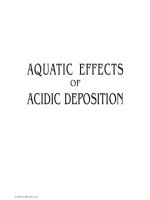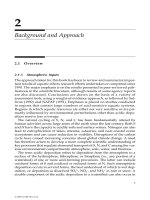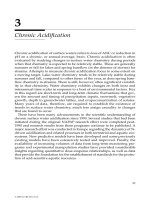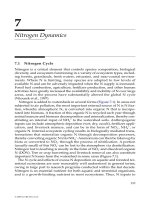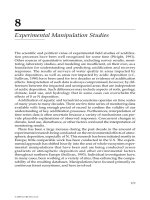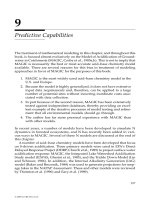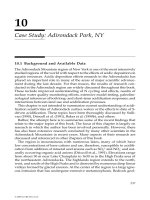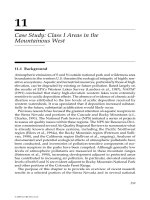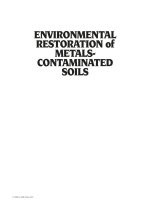Restoration of Aquatic Systems - Chapter 1 pot
Bạn đang xem bản rút gọn của tài liệu. Xem và tải ngay bản đầy đủ của tài liệu tại đây (972.32 KB, 24 trang )
Restoration of
Aquatic Systems
© 2006 by Taylor & Francis Group, LLC
Marine Science Series
The CRC Marine Science Series is dedicated to providing state-of-the-art
coverage of important topics in marine biology, marine chemistry, marine
geology, and physical oceanography. The series includes volumes that focus
on the synthesis of recent advances in marine science.
CRC MARINE SCIENCE SERIES
SERIES EDITOR
Michael J. Kennish, Ph.D.
P
UBLISHED TITLES
Artificial Reef Evaluation with Application to Natural Marine Habitats,
William Seaman, Jr.
The Biology of Sea Turtles, Volume I, Peter L. Lutz and John A. Musick
Chemical Oceanography, Second Edition, Frank J. Millero
Coastal Ecosystem Processes, Daniel M. Alongi
Ecology of Estuaries: Anthropogenic Effects, Michael J. Kennish
Ecology of Marine Bivalves: An Ecosystem Approach, Richard F. Dame
Ecology of Marine Invertebrate Larvae, Larry McEdward
Ecology of Seashores, George A. Knox
Environmental Oceanography, Second Edition, Tom Beer
Estuarine Indicators, Stephen A. Bortone
Estuarine Research, Monitoring, and Resource Protection, Michael J. Kennish
Estuary Restoration and Maintenance: The National Estuary Program,
Michael J. Kennish
Eutrophication Processes in Coastal Systems: Origin and Succession
of Plankton Blooms and Effects on Secondary Production in
Gulf Coast Estuaries, Robert J. Livingston
Handbook of Marine Mineral Deposits, David S. Cronan
Handbook for Restoring Tidal Wetlands, Joy B. Zedler
Intertidal Deposits: River Mouths, Tidal Flats, and Coastal Lagoons,
Doeke Eisma
Marine Chemical Ecology, James B. McClintock and Bill J. Baker
Morphodynamics of Inner Continental Shelves, L. Donelson Wright
Ocean Pollution: Effects on Living Resources and Humans, Carl J. Sindermann
Physical Oceanographic Processes of the Great Barrier Reef, Eric Wolanski
The Physiology of Fishes, Second Edition, David H. Evans
Pollution Impacts on Marine Biotic Communities, Michael J. Kennish
Practical Handbook of Estuarine and Marine Pollution, Michael J. Kennish
Practical Handbook of Marine Science, Third Edition, Michael J. Kennish
Seagrasses: Monitoring, Ecology, Physiology, and Management,
Stephen A. Bortone
Trophic Organization in Coastal Systems, Robert J. Livingston
© 2006 by Taylor & Francis Group, LLC
Boca Raton London New York Singapore
A CRC title, part of the Taylor & Francis imprint, a member of the
Taylor & Francis Group, the academic division of T&F Informa plc.
Restoration of
Aquatic Systems
Robert J. Livingston
Director
Center for Aquatic Research and Resource Management
Florida State University
Tallahassee
© 2006 by Taylor & Francis Group, LLC
Published in 2006 by
CRC Press
Taylor & Francis Group
6000 Broken Sound Parkway NW, Suite 300
Boca Raton, FL 33487-2742
© 2006 by Taylor & Francis Group, LLC
CRC Press is an imprint of Taylor & Francis Group
No claim to original U.S. Government works
Printed in the United States of America on acid-free paper
10987654321
International Standard Book Number-10: 0-8493-1966-8 (Hardcover)
International Standard Book Number-13: 978-0-8493-1966-2 (Hardcover)
Library of Congress Card Number 2004064948
This book contains information obtained from authentic and highly regarded sources. Reprinted material is quoted with
permission, and sources are indicated. A wide variety of references are listed. Reasonable efforts have been made to publish
reliable data and information, but the author and the publisher cannot assume responsibility for the validity of all materials
or for the consequences of their use.
No part of this book may be reprinted, reproduced, transmitted, or utilized in any form by any electronic, mechanical, or
other means, now known or hereafter invented, including photocopying, microfilming, and recording, or in any information
storage or retrieval system, without written permission from the publishers.
01923, 978-750-8400. CCC is a not-for-profit organization that provides licenses and registration for a variety of users. For
organizations that have been granted a photocopy license by the CCC, a separate system of payment has been arranged.
Trademark Notice: Product or corporate names may be trademarks or registered trademarks, and are used only for
identification and explanation without intent to infringe.
Library of Congress Cataloging-in-Publication Data
Livingston, Robert J.
Restoration of aquatic systems / by Robert J. Livingston.
p. cm. –- (Marine science series)
Includes bibliographical references (p. ) and index.
ISBN 0-8493-1966-8
Restoration ecology–-Florida. 2. Aquatic ecology-–Florida. 3. Wildlife habitat improvement–-Florida.
I. Title. II. Series.
QH105.F6L582 2005
639.9—dc22 2004064948
Visit the Taylor & Francis Web site at
and the CRC Press Web site at
Taylor & Francis Group
is the Academic Division of T&F Informa plc.
1966_Discl.fm Page 1 Friday, June 3, 2005 7:52 AM
© 2006 by Taylor & Francis Group, LLC
( or contact the Copyright Clearance Center, Inc. (CCC) 222 Rosewood Drive, Danvers, MA
For permission to photocopy or use material electronically from this work, please access www.copyright.com
“The road to Perdition is paved with good intentions.”
—
Unattributed aphorism
“Approximately 80% of our air pollution stems from hydrocarbons released by
vegetation, so let’s not go overboard in setting and enforcing tough emission
standards from man-made sources.”
—
Ronald Reagan
“No witchcraft, no enemy action had silenced the re-birth of new life in this
stricken world. The people had done it themselves.”
—Rachel Carson,
Silent Spring
“A vast and destructive algae bloom has floated out of the backcountry and
settled near Islamorada. …Crossing the tall arch to Long Key, you noticed a
foul-looking stain stretching gulfward to the horizon. What you saw is Florida
Bay dying.”
—
Carl Hiaasen,
Miami Herald
, 1993
“It sounds like a bad 1950s science fiction movie: ugly green slime spreading
through the sea, killing fish and threatening children and animals that swim
in the water. But experts say this scenario could become reality in the Baltic,
the world’s largest brackish water sea…”
—Nina Garlo, Reuters article, 2003
“A foolish consistency is the hobgoblin of little minds.”
—
Ralph Waldo Emerson
“Collectively, the restoration effort is billed as the nation’s premier watershed
restoration program and is billed as a model for estuarine restoration programs
worldwide. All the while, decades pass and the Bay’s most basic environmental
indicators suggest little if any sustained improvement…. As the region’s polit-
ical system continues to grapple with environmental protection, it is important
not to adjust environmental goals to reflect ‘political realities’ or to grow content
with hollow ‘successes’ that fail to reflect tangible environmental improve-
ments.”
—Howard R. Ernst,
Chesapeake Blues,
2003
1966_C000.fm Page v Tuesday, June 7, 2005 1:30 PM
© 2006 by Taylor & Francis Group, LLC
Preface
The research effort on which this book is based has involved continuous analyses of
various river–estuarine and coastal systems in the southeastern United States since 1970.
These long-term studies have been carried out using a combination of field descriptive
and experimental (lab and field) approaches. The research team for this work has included
field collection personnel, chemists, taxonomists, experimental biologists, physical ocean-
ographers, hydrological engineers, statisticians, computer programmers, and modelers. A
long-term, interdisciplinary, comparative database has been created that is currently being
published in a series of books and peer-reviewed scientific journals. This program has
been used to evaluate system-level processes that determine the effects of nutrient loading
and nutrient dynamics on phytoplankton/benthic macrophyte productivity and associ-
ated food web responses. Efforts have been made to determine how human activities affect
these processes. The emphasis of the research has been on seasonal and interannual trophic
response to habitat changes and an evaluation of the interrelationships of cultural eutroph-
ication and toxic substances on secondary production. This research is currently being
used to develop realistic indices of ecosystem condition and determine restoration methods.
This book includes several features that have been integrated using the ecosystem
evaluations to determine the efficacy of habitat rehabilitation. In addition, information
regarding the way in which the scientific data have been reported by American news
media and the public response to such information have also been analyzed. The long-
evaluation of the efficacy of the restoration process. The various components of the res-
toration of damaged aquatic systems are not restricted to the scientific effort. Other factors
include economic and political interests, information dissemination, public response, and
the complex synergism that goes into controversial environmental issues. This book is
thus concerned with just how effective the restoration process becomes as a product of a
complex mixture of competing interests. The primary emphasis is on the relationship of
scientific research to the rehabilitation of aquatic habitats.
1966_C000.fm Page vii Tuesday, June 7, 2005 1:30 PM
© 2006 by Taylor & Francis Group, LLC
term database (Table 1) has thus been used as objective background material for an
Table 1
Field/Experimental Effort of the Florida State University Research Group from 1970 to 2004
System Met. PC LC POL PHYTOPL SAV ZOOPL INFAUNA INV FISHES FW NL NR
North Florida Lakes 35 14 14 5 6 2 1 2 2 2 2 1 1
Apalachicola System 85 17 2 2 1 1 1 8 14 14 8 2 nd
Apalachee Bay 50 26 12 2 5 15 3 2 18 19 26 3 1
Perdido River–Bay 50 16 16 3 13 3 3 16 16 16 16 16 1
Pensacola Bay System 30 1.5 1.5 1 1.5 nd 1.5 1.5 1.5 1.5 1.5 1.5 nd
Blackwater–East Bay System 4 1.5 1.5 1 nd 1 nd 1.5 1.5 1.5 1.5 1.5 nd
Escatawpa System 5 2 2 2 nd nd nd 2 2 2 nd nd nd
Choctawhatchee River–Bay 30 4 4 2 2 1 2 4 4 4 2 2 nd
Mobile River Estuary 3 2 2 2 nd nd nd 2 2 2 nd nd nd
Nassau–Amelia Estuaries 3 3 3 2 3 3 3 2 1 1 2 nd 1
Sampit River–Winyah Bay System 5 4 4 4 nd nd nd 4 2 2 nd nd nd
Met. = river flow, rainfall.
PC = salinity, conductivity, temperature, dissolved oxygen, oxygen anomaly
, pH, depth, Secchi.
LC = NH
3
, NO
2
, NO
3
, TIN, PON, DON, TON, TN, PO
4
, TDP, TIP, POP, DOP, TOP, TP, DOC, POC, TOC, IC, TIC, TC, BOD, silicate, TSS, TDS, DIM, DOM, POM, PIM,
NCASI color, turbidity, chlorophyll
a
,
b
,
c
, sulfide.
POL = water/sediment pollutants (pesticides, metals, PAH).
PHYTOPL = whole water and/or net phytoplankton.
SAV = submerged aquatic vegetation.
ZOOPL. = net zooplankton.
INFAUNA = infaunal macroinvertebrates taken with cores and/or ponars.
INV = invertebrates taken with seines (freshwater) and otter trawls (bay).
FISHES = fishes taken with seines (freshwater) and otter trawls (bay).
FW = food web transformations.
NL= nutrient loading.
NR = nutrient limitation experiments.
nd = no data.
1966_C000.fm Page viii Tuesday, June 7, 2005 1:30 PM
© 2006 by Taylor & Francis Group, LLC
About the Author
Robert J. Livingston
is currently Professor Emeritus of the Department of Biological
Sciences at Florida State University (Tallahassee, Florida, USA). His interests include
aquatic ecology, pollution biology, field and laboratory experimentation, and long-term
ecosystem-level research in freshwater, estuarine, and marine systems. Past research
includes multidisciplinary studies of lakes and a series of drainage systems on the Gulf
and East coasts of the United States. Over the past 35 years, Livingston’s research group
has conducted a series of studies in areas from Maine to Mississippi. Dr. Livingston has
directed the programs of 49 graduate students who have carried out research in behavioral
and physiological ecology with individual aquatic populations and communities in lakes,
rivers, and coastal systems. He is the author of more than 170 scientific papers and five
books on the subject of aquatic ecology, and has been the principal investigator for more
than 100 projects since 1970.
The primary research program of the author has been carried out largely in the
southeastern United States. The areas studied include the Apalachicola drainage system,
the Choctawhatchee drainage system, the Perdido drainage system, the Escambia River
and Bay system, the Blackwater River estuary, the Escatawpa Pascagula drainage system,
the Mobile River estuary, the Winyah Bay system (including the Sampit River), Apalachee
Bay (the Econfina and Fenholloway River estuaries) and a series of north Florida lake
of anthropogenous activities on a range of physical, chemical, and biological processes.
A computer system has been developed to aid in the analysis of the established long-
term databases. Together with associates and former graduate students, Livingston is
currently in the process of publishing the long-term database. Field research is ongoing
in the Perdido system. Retirement is not an option.
1966_C000.fm Page ix Tuesday, June 7, 2005 1:30 PM
© 2006 by Taylor & Francis Group, LLC
systems (Table 1). This work has included determinations of the impact of various forms
Acknowledgments
There were many people who contributed to the research effort over the past 35 years. It
is impossible to acknowledge all these people. Literally thousands of undergraduate
students, graduate students, technicians, and staff personnel have taken part in the long-
term field ecology programs. Various people have been involved in CARRMA research
associated with the Center for Aquatic Research and Resource Management at Florida
State University for the study period.
The program has had the support and cooperation of various experts. Dr. A.K.S.K.
Prasad studied phytoplankton taxonomy and systematics. Robert L. Howell IV, ran the
field collections and identified fishes and invertebrates. Glenn C. Woodsum designed the
overall database organization and, together with Phillip Homann, ran database manage-
ment and day-to-day data analysis of the research information. Dr. F. Graham Lewis III,
was instrumental in the development of analytical procedures and statistical analyses.
Dr. David A. Flemer designed the overall approach for analytical chemistry. Dr. Duane A.
Meeter, Dr. Xufeng Niu, and Loretta E. Wolfe performed statistical analyses. The taxonomic
consistency of the field collections was carried out with the help of world-class system-
atists, including Dr. John H. Epler (aquatic insects), Dr. Carter R. Gilbert and Dr. Ralph
Yerger (freshwater fishes), and Dr. Clinton J. Dawes (submerged aquatic vegetation).
The long-term field ecological program has benefited from the advice of a distin-
guished group of scientists. Dr. John Cairns, Jr., Mr. Bori Olla, Dr. E.P. Odum, Dr. J.W.
Hedgpeth, Dr. O. Loucks, Dr. K. Dickson, Dr. F.J. Vernberg, and Dr. Ruth Patrick reviewed
the early work. Dr. D.M. Anderson, Dr. A.K.S.K. Prasad, Mr. G.C. Woodsum, Dr. M.J.
Kennison, Dr. K. Rhew, Dr. M. Kennish, Dr. E. Fernald, Dr. David C. White, and Ms. V.
Tschinkel have reviewed various aspects of the recent work. Other reviews have been
provided by Dr. C.H. Peterson, Dr. S. Snedaker, Dr. R.W. Virnstein, Dr. D.C. White, Dr. E.D.
Estevez, Dr. J.J. Delfino, Dr. F. James, Dr. W. Herrnkind, and Dr. J. Travis. Dr. Eugene P.
Odum gave me the good advice to write up our results in a series of books, which turned
out to be the only way our work could be adequately treated.
Over the years, we have had a long list of excellent co-investigators who have partic-
ipated in various projects. Recent collaborative efforts in the field have included the
following scientists: Dr. D.C. White (microbiological analyses), Dr. D.A. Birkholz (toxicology,
residue analyses), Dr. G.S. Brush (long-core analysis), Dr. L.A. Cifuentes, (nutrient studies,
isotope analyses), Dr. K. Rhew (microalgal analyses), Dr. R.L. Iverson (primary produc-
tivity), Dr. R.A. Coffin (nutrient studies, isotope analyses), Dr. W.P. Davis (biology of
fishes), Dr. M. Franklin (riverine hydrology), Dr. T. Gallagher (hydrological modeling),
Dr. W.C. Isphording (marine geology), Dr. C.J. Klein III (aquatic engineering, estuarine
modeling), Dr. M.E. Monaco (trophic organization), Dr. R. Thompson (pesticide analyses),
Dr. W. Cooper (chemistry), Mr. D. Fiore (chemistry), and Dr. A.W. Niedoroda (physical
oceanography).
We have had unusually strong support in the statistical analyses and modeling of our
data, a process that is continuing to this day. These statistical determinations and modeling
1966_C000.fm Page xi Tuesday, June 7, 2005 1:30 PM
© 2006 by Taylor & Francis Group, LLC
efforts have been carried out by the following people: Dr. T.A. Battista (National Oceanic
and Atmospheric Administration), Dr. B. Christensen (University of Florida), Dr. J.D.
Christensen (National Oceanic and Atmospheric Administration), Dr. M.E. Monaco
(National Oceanic and Atmospheric Administration), Dr. Tom Gallagher (Hydroqual, Inc.),
Dr. B. Galperin (University of South Florida), and Dr. W. Huang (Florida State University).
Experimental field and laboratory ecology has been carried out by the following
graduate students: Dr. B.M.S. Mahoney (experimental biology), Dr. K. Main (experimental
biology), Dr. Frank Jordan (biology of fishes), Dr. Ken Leber (experimental biology),
Dr. W.H. Clements (trophic analyses), Dr. C.C. Koenig (fish biology), Dr. P. Sheridan
(trophic analyses), Dr. J. Schmidt (aquatic macroinvertebrates), Dr. A.W. Stoner (trophic
analyses), Dr. R.A. Laughlin (trophic analyses), Dr. J.L. Luczkovich (experimental biology),
Dr. J. Holmquist (experimental biology), Dr. D. Bone (experimental biology), Dr. B.
MacFarlane (biology of fishes), Ms. C. Phillips (experimental biology), Mr. M. Kuperberg
(submerged aquatic vegetation), Ms. T.A. Hooks (experimental biology), Mr. Joseph Ryan
(trophic analyses), Mr. C.J. Boschen (trophic analyses), Mr. G.G. Kobylinski (experimental
biology), Mr. C.R. Cripe (experimental biology), Mr. T. Bevis (biology of fishes), Mr. P.
Muessig (experimental biology), Ms. S. Drake (experimental biology), Mr. K.L. Heck, Jr.
(experimental biology), Ms. H. Greening (aquatic macroinvertebrates), Mr. Duncan Cairns
(experimental biology), Ms. K. Brady (larval fishes), Mr. B. McLane (aquatic macroinver-
tebrates), Ms. B. Shoplock (zooplankton), Ms. J.J. Reardon (phytoplankton, submerged
aquatic vegetation), and Ms. J. Schmidt-Gengenbach (experimental biology).
Taxonomy is at the heart of a comprehensive ecosystem program, which is something
I learned from my major professors (Dr. Carl Hubbs, Dr. C. Richard Robbins, Dr. Arthur
A. Myrberg, and Dr. Charles E. Lane) while attending graduate school. Our attention to
systematics and natural history has benefited from the efforts of a long line of graduate
students, post-doctoral fellows, and trained technicians who include the following:
Dr. A.K.S.K. Prasad and Dr. K. Rhew (phytoplankton, benthic microalgae), Dr. F. Graham
Lewis III (aquatic macroinvertebrates), Dr. J. Epler (aquatic macroinvertebrates), Dr. R.D.
Kalke (estuarine zooplankton), Dr. G.L. Ray (infaunal macroinvertebrates), Dr. K.R. Smith
(oligochaetes), Dr. E. L. Bousfield (amphipods), Dr. F. Jordan (trophic analyses), Dr. C.J.
Dawes (submerged aquatic vegetation), Dr. R.W. Yerger and Dr. Carter Gilbert (fishes),
Mr. R.L. Howell III (infaunal and epibenthic invertebrates and fishes), Mr. W.R. Karsteter
(freshwater macroinvertebrates), and Mr. M. Zimmerman (submerged aquatic vegetation).
A number of phycologists have given their time to the taxonomy and nomenclature
of phytoplankton species over the years: Dr. C.W. Reimer (Academy of Natural Sciences
of Philadelphia), Dr. G.A. Fryxell (University of Texas at Austin), Dr. G.R. Hasle (University
of Oslo, Norway), Dr. P. Hargraves (University of Rhode Island), Professor F. Round
(University of Bristol, England), Mr. R. Ross, Ms. P.A. Sims, Dr. E.J. Cox and Dr. D.M.
Williams (British Museum of Natural History, London, United Kingdom), Dr. L.K. Medlin
and Dr. R.M. Crawford (Alfred-Wegener Institute, Bremerhaven, Germany), Professor T.V.
Desikachary (University of Madras, India), Dr. J.A. Nienow (Valdosta State University,
Georgia), Dr. P. Silva (University of California at Berkeley), Dr. M.A. Faust (Smithsonian
Institution), Dr. R.A. Andersen (Bigelow Laboratory for Ocean Sciences, Maine), Dr. D.
Wujeck (Michigan State University), Dr. M. Melkonian (University of Koln, Germany),
Dr. C.J. Tomas (Florida Department of Environmental Regulation, St. Petersburg), Profes-
sor T.H. Ibaraki (Japan), Dr. Y. Hara (University of Tsukuba, Japan), and Dr. J. Throndsen
(University of Oslo, Norway). Technical assistance with transmission and scanning elec-
tron microscopes was provided by Ms. K.A. Riddle (Department of Biological Science,
Florida State University). Mrs. A. Black and Mr. D. Watson (Histology Division, Depart-
ment of Biological Science, Florida State University) aided in specimen preparation and
serial thin sectioning.
1966_C000.fm Page xii Tuesday, June 7, 2005 1:30 PM
© 2006 by Taylor & Francis Group, LLC
The curators of various International Diatom Herbaria have aided in the loan of type
collections and other authentic materials: Academy of Natural Sciences of Philadelphia
(ANSP), California Academy of Sciences (CAS) (San Francisco), National Museum of
Natural History, Smithsonian Institution (Washington, D.C.), Harvard University Herbaria
(Cambridge. Massachusetts), The Natural History Museum (BM) (London, United King-
dom), and the F. Hustedt Collections, Alfred Wegener Institute (Bremerhaven, Germany).
Others have collaborated on various aspects of the field analyses. Mr. W. Meeks, Mr. B.
Bookman, Dr. S.E. McGlynn, and Mr. P. Moreton ran the chemistry laboratories. Mr. O.
Salcedo, Ms. I. Salcedo, Mr. R. Wilt, Mr. S. Holm, Ms. L. Bird, Ms. L. Doepp, Ms. C. Watts,
and Ms. M. Guerrero-Diaz provided other forms of lab assistance. Field support for the
various projects was provided by Mr. H. Hendry, Mr. A. Reese, Ms. J. Scheffman, Mr. S.
Holm, Mr. M. Hollingsworth, Dr. H. Jelks, Ms. K. Burton, Ms. E. Meeter, Ms. C. Meeter,
Ms. S. Solomon, S.S. Vardaman, Ms. S. van Beck, Mr. M. Goldman, Mr. S. Cole, Mr. K.
Miller, Mr. C. Felton, Ms. B. Litchfield, Mr. J. Montgomery, Ms. S. Mattson, Mr. P. Rygiel,
Mr. J. Duncan, Ms. S. Roberts, Mr. T. Shipp, Ms. A. Fink, Ms. J.B. Livingston, Ms. R.A.
Livingston, Ms. J. Huff, Mr. R.M. Livingston, Mr. A.S. Livingston, Mr. T. Space, Mr. M.
Wiley, Mr. D. Dickson, Ms. L. Tamburello, and Mr. C. Burbank.
Project administrators included the following people: Dr. T.W. Duke, Dr. R. Schwartz,
Dr. M.E. Monaco, Ms. J. Price, Dr. N.P. Thompson, Mr. J.H. Millican, Mr. D. Arceneaux,
Mr. W. Tims, Jr., Dr. C.A. Pittinger, Mr. M. Stellencamp, Ms. S.A. Dowdell, Mr. C. Thompson,
Mr. K. Moore, Dr. E. Tokar, Dr. D. Tudor, Dr. E. Fernald, Ms. D. Giblon, Ms. S. Dillon,
Ms. A. Thistle, Ms. M.W. Livingston, and Ms. C. Wallace.
Robert J. Livingston and Julia B. Livingston designed the book cover.
1966_C000.fm Page xiii Tuesday, June 7, 2005 1:30 PM
© 2006 by Taylor & Francis Group, LLC
Contents
Section I: Definitions
Chapter 1 The Restoration Paradigm 3
1.1 Definitions 3
1.2 Ecosystem Research and Restoration 3
1.3 Human Impacts on Aquatic Systems 4
1.4 The Paradox of Actual Risks and Public Concerns 6
1.5 Factors for Successful Restoration 7
Section II: North Florida as a Microcosm of the Restoration Paradigm
Chapter 2 Cultural Eutrophication of North Florida Lakes 13
2.1 Background of Solution (Sinkhole) Lakes 13
2.2 Urban Runoff and Solution Lakes 16
2.3 Lake Ecology Program 17
2.4 Urban Runoff and Lake Jackson 17
2.4.1 Background 17
2.4.2 Long-Term Cycles of Rainfall and Storm Water Runoff 20
2.4.3 Water Quality Changes 22
2.4.4 Sediment Changes 22
2.5 Submerged Aquatic Vegetation 26
2.6 Blue-Green Algae Blooms 28
2.7 Biological Response to Blooms 33
2.7.1 Infaunal Macroinvertebrates 34
2.7.2 Fishes 35
2.7.2.1 Fish Diseases 35
2.7.2.2 Fish Distribution 36
2.7.2.3 Fish Trophic Response to Algal Blooms 37
2.7.2.4 Long-Term Trends of Largemouth Bass Size 38
2.8 Lake Jackson Restoration Efforts 38
2.9 Urban Runoff and North Florida Lakes 39
2.9.1 Lake Hall 40
2.9.2 Lake Lafayette Basin 40
2.9.3 Lake Munson 43
2.10 Holding Pond Ecology 44
2.11 Press Coverage and Public Response 46
2.12 The Failure of Restoration 52
1966_C000.fm Page xv Tuesday, June 7, 2005 1:30 PM
© 2006 by Taylor & Francis Group, LLC
Chapter 3 Industrial Pollution: Pulp Mills 55
3.1 Study Area 55
3.2 River Flows, Nutrient Loading, and Water Quality Changes 64
3.3 Biological Responses in Freshwater Receiving Areas 67
3.3.1 Mill Effects on Freshwater Biota: Fenholloway River 67
3.3.1.1 Periphyton 67
3.3.1.2 Hester-Dendy Macroinvertebrates 68
3.3.1.3 Suction Dredge Macroinvertebrates 69
3.3.1.4 Fishes 69
3.3.1.5 Phytoplankton 72
Chapter 4 Pulp Mill Effluents and Apalachee Bay 79
4.1 Study Area 79
4.2 Impact Analyses 80
4.3 Water Quality 82
4.3.1 Rainfall and River Flow 82
4.3.2 Temperature and Salinity 83
4.3.3 Dissolved Oxygen 84
4.3.4 Watercolor and Light Transmission 85
4.4 Sediment Quality 88
4.4.1 Toxic Agents 89
4.4.2 Nutrients 90
4.5 Nutrients: Loading, Limitation, and Concentration 91
4.5.1 Nutrient Loading 91
4.5.2 Nutrient Limitation 92
4.5.3 Nutrient Concentration Gradients 93
4.6 Phytoplankton and Zooplankton 93
4.6.1 Introduction 93
4.6.2 Chlorophyll
a
Trends 93
4.6.3 Phytoplankton Distribution (1992–1993) 94
4.6.4 Color Removal and Bloom Generation 97
4.6.5 Comparison of Perdido Bay and Apalachee Bay 106
4.6.6 Zooplankton Distribution 110
4.7 Submerged Aquatic Vegetation 110
4.7.1 SAV Distribution in Space and Time 110
4.8 Invertebrates 115
4.9 Fishes 118
4.10 Summary of Findings 120
4.10.1 Water Quality 120
4.10.2 Chlorophyll
a
121
4.10.3 Phytoplankton 123
4.10.4 Submerged Aquatic Vegetation 128
4.10.5 Invertebrates 129
4.10.6 Fishes 146
4.11 Press Coverage, Public Response, and Failure of the Restoration Process 151
Chapter 5 Nutrient Loading and the Perdido System 159
5.1 Phytoplankton Blooms in Coastal Systems 159
5.2 Research in the Perdido River-Bay System 160
5.3 History of Results 162
5.3.1 River Flow Trends 162
5.3.2 Nutrient Loading 163
1966_C000.fm Page xvi Tuesday, June 7, 2005 1:30 PM
© 2006 by Taylor & Francis Group, LLC
5.3.3 Nutrient Concentrations and Ratios 165
5.3.4 Phytoplankton Trends: Bloom Distribution 165
5.3.5 Response to Nutrient Restoration Program 170
5.3.6 Bay Impacts (Fall 2002–Summer 2003) 173
5.3.7 Non-point Nutrient Sources: Agricultural and Urban Runoff 177
5.3.8 Statistical Analyses of the Long-Term Data 180
5.4 The Press and the Perdido System 184
5.4.1 The Dioxin Issue 185
5.4.2 Cumulative Impacts of Development on Perdido Bay 187
5.4.3 The News Media and Perdido Bay 190
Chapter 6 The Pensacola Bay System 195
6.1 Background 195
6.2 Purpose of Study 195
6.3 Summary of Results 196
6.4 Contamination of the Pensacola System 199
6.4.1 Upper Escambia Bay 200
6.4.2 Lower Escambia Bay 201
6.5 The Press and the Pensacola Bay System 203
Chapter 7 Sulfite Pulp Mill Restoration 207
7.1 Introduction 207
7.1.1 Study Area 208
7.2 Methods and Materials 209
7.3 Results 210
7.3.1 Water Quality Data 210
7.3.2 Light Transmission 214
7.3.3 Phytoplankton and Zooplankton 214
7.3.4 Multivariate Statistical Analyses 219
7.3.4.1 Laboratory Microcosms 221
7.3.4.2 Field Mesocosms 222
7.4 Discussion and Conclusions 222
7.5 Restoration Program 223
7.5.1 Physicochemical Conditions 224
7.5.2 Light Trends 227
7.5.3 Phytoplankton Analyses 227
7.5.4 Zooplankton Analyses 227
7.5.5 Multivariate Statistical Analyses 229
7.6 Discussion of the Amelia Program 231
Chapter 8 Research, News Reports, and Restoration Success 235
8.1 Restoration Processes and Public Opinion 235
8.2 Florida as a Microcosm for Restoration Activities 236
8.3 Comparison of Research Results, Media Coverage,and Public Response 237
8.4 Summary of Recent Trends in North Florida 240
Section III: Major Restoration Programs
Chapter 9 The Chesapeake Bay System 245
9.1 A Declining Resource 245
9.2 Research Results 246
1966_C000.fm Page xvii Tuesday, June 7, 2005 1:30 PM
© 2006 by Taylor & Francis Group, LLC
9.2.1 Hypoxia 246
9.2.2 Phytoplankton 248
9.2.3 Toxic Substances and Over-fishing 249
9.3 The Chesapeake Restoration Program 250
9.4 Reality Sets In: The Rainfall of 2003 251
Chapter 10 Kissimmee–Okeechobee–Florida Everglades–Florida Bay–Coral
Reef System 257
10.1 The System 257
10.2 Background 259
10.2.1 Kissimmee River–Lake Okeechobee 259
10.2.2 Florida Everglades 260
10.2.3 Florida Bay 261
10.2.4 Florida Keys, Coral Reefs 262
10.3 Water Quality in the Florida Everglades System 263
10.3.1 Mercury 263
10.3.2 Nutrients 264
10.3.2.1 Relationships of Nutrient Loading and Water Quality 265
10.4 Recent Evaluations of the Everglades Ecosystem 267
10.5 Management and Restoration 269
10.6 The News Media and Public Involvement 271
Section IV: Restoration of Toxic Waste Sites
Chapter 11 Mercury and Dioxin in Aquatic Systems 277
11.1 Mercury in the Aquatic Environment 277
11.2 Penobscot River–Bay System in Maine 278
11.2.1 Background 278
11.2.2 Mercury in the Penobscot River–Bay System 279
11.2.3 The “Wetlands Hypothesis” 281
11.2.4 Proposed Restoration of the Penobscot System 283
11.2.5 Legal Solution to the Penobscot Mercury Problem 284
11.3 Mercury in the South River–South Fork Shenandoah River 284
11.3.1 Background 284
11.3.2 Mercury in the South River–South Fork System 284
11.3.3 Ongoing Studies 286
11.3.4 Resolution 287
11.4 Dioxin in the Aquatic Environment 287
11.4.1 Background of Dioxin in the Newark Bay Complex 287
11.4.2 Dioxin in Fish and Invertebrate Tissues 289
11.4.3 Newark Bay Ecology: Fate, Effects, and Restoration 290
11.4.4 Legal Action and Regulatory Response 292
11.5 Regulatory Requirements and the Restoration Process 292
11.6 Press Response to Toxic Substances 292
Section V: Alternatives: Planning and Management
Chapter 12 The Apalachicola System 297
12.1 Background 297
12.2 Apalachicola River Flows 298
1966_C000.fm Page xviii Tuesday, June 7, 2005 1:30 PM
© 2006 by Taylor & Francis Group, LLC
12.2.1 Apalachicola Floodplain 298
12.3 Linkage between the Apalachicola River and the Bay 299
12.4 Freshwater Flows and Bay Productivity 302
12.5 Planning and Management of the Apalachicola Bay System 305
12.5.1 Wetlands Purchases 305
12.5.2 Local, State, and Federal Cooperation 308
12.5.2.1 The Beginning: 1972 to 1977 309
12.5.2.2 The Middle Years: 1978 to 1982 311
12.5.2.3 1983 to the Present 313
12.6 Water Use in the ACF System 314
12.7 The Apalachicola Model: Management, not Restoration 315
Chapter 13 Conclusions 317
13.1 Introduction 317
13.2 Scientific Research 320
13.3 Regulation and Enforcement 321
13.4 Public Education 323
13.5 Legal Action 324
13.6 News Media 324
13.7 The Ecology of Restoration 326
13.8 Economic/Political Considerations 326
Section VI: Appendices
Appendix I Field/Laboratory Research Outlines and Methods 331
Appendix II Statistical Analyses Used in the Long-Term Studies of Aquatic
Systems 389
References 393
1966_C000.fm Page xix Tuesday, June 7, 2005 1:30 PM
© 2006 by Taylor & Francis Group, LLC
section I
Definitions
The restoration of aquatic systems has become an important object of research organiza-
tions throughout the world. Most of this effort is directed at minor parts of a given drainage
system; popular restoration efforts consist of replanting individual marshes and isolated
seagrass beds, and the building of new ponds, or replanting denuded upland areas with
trees. Citizen-oriented restoration efforts abound, with a variety of community activities
that include solid waste removal and a broad array of water quality monitoring programs.
These restoration activities are not addressed here for several reasons. Seldom are such
efforts grounded on solid scientific investigations. Often, there is media hype that is
devoted more to political considerations than actual restoration. And there is almost
always a lack of scientific information with regard to the actual efficacy of a given resto-
ration effort. Instead, this author is mainly interested in system-level restoration activities
that purport to use the scientific process to restore entire lakes, rivers, and coastal systems
to some former level of productivity. These efforts include some of the most important
aquatic systems in the world.
The definition of a given restoration effort should include some reference to the natural
habitat, the human activities in the region of interest, and the inclusion of unavoidable
impacts due to natural causes. That is, there should be some knowledge of system pro-
cesses so that realistic goals can be projected for the restoration process. This information
should also include an estimate of the natural productivity of the target system, the human
health aspects involved, the biodiversity of the original system, the state of the fisheries
potential (past and present), and the possibilities for enhancement of aesthetic qualities
of the natural ecosystem. That is, the restoration process should be addressed as the formal
use of scientific and engineering methods to bring back damaged aquatic systems to some
level of natural productivity. This effort should be made within the limits of the natural
productivity of the system in question.
1966_book.fmPage1Friday,June3,20059:20AM
© 2006 by Taylor & Francis Group, LLC
3
chapter 1
The Restoration Paradigm
1.1 Definitions
There are many interpretations of the term “restoration.” According to the National Oce-
anic and Atmospheric Administration (NOAA, 1995), restoration is defined as “the process
of reestablishing a self-sustaining habitat that closely resembles a natural condition in
terms of structure and function.” The Environmental Protection Agency (EPA U.S. Envi-
ronmental Protection Agency, 2003) defines restoration as “the return of a degraded eco-
system to a close approximation of its remaining natural potential.” Another interpretation
of ‘restoration’ relates to the return of a polluted or degraded environment to a successful,
self-sustaining ecosystem with both clean water and healthy habitats. If the definition
includes a return to the “original natural system,” this assumes that the attributes of the
original system are known, which is seldom the case. There are varied interpretations of
the “success” of individual restoration efforts. This is complicated by endless philosophical
discussions on an academic level concerning the actual meaning of the term. To add to
the complication of interpretation, there are different levels of restoration efforts that range
from attempts to restore minor wetland areas and individual grass beds to the proposed
recovery of entire ecosystems. The factors that contribute to “successful” restoration efforts
are not restricted to scientific efforts. These include political, economic, legal, and socio-
logical processes that often supersede the science in terms of influence on the outcome.
These factors are seldom mentioned when a given restoration effort is developed.
Whatever definition is accepted for a given restoration effort, the process should
include some reference to factors that include the following: natural habitat, human uses
in the region of interest, and inclusion of unavoidable impacts due to human activities. It
should also include an estimate of the natural productivity of the aquatic system in
question. Other contributing factors include human health aspects, the biodiversity of the
original system, the state of existing fisheries, and possibilities for enhancement of aesthetic
qualities. That is, restoration should be addressed as the formal use of scientific and
engineering methods to bring back aquatic systems that have been damaged by human
activities to some level of natural productivity. Most of all, however, there should be a
clear definition of the goals of a given restoration effort. Such goals should be realistic,
with the clear realization that a return to the “pristine” state is seldom if ever a possibility.
1.2 Ecosystem Research and Restoration
The ecosystem concept is the basis of resource management issues in aquatic systems.
Although the definition of what constitutes ecosystem-level research is continuously
debated by aquatic scientists, the purpose of such analyses (i.e., development of a factual
1966_book.fmPage3Friday,June3,20059:20AM
© 2006 by Taylor & Francis Group, LLC
4 Restoration of Aquatic Systems
basis that is used for system management) remains relatively clear. Because ecosystem
research is often used to answer questions that are not necessarily asked at the beginning
of the program, such research must remain open-ended so that it can be applied to
unanticipated impacts. Ecosystem processes cannot be defined entirely by
post hoc
accu-
mulations of information. In many ways, the application of even comprehensive scientific
data to the management of coastal systems is not direct, and requires a multidisciplinary
approach that often goes beyond the mere assembly of facts. This application can be
successful (Livingston, 2002) but requires diverse and innovative approaches to problem
solving.
A successful ecosystem approach requires a very different set of initial research ques-
tions than that of the usual hypothesis-testing process. These questions are often limited
by unknown factors that will occur in the future, and thus require a database that can
eventually address future information needs of complex questions. In ecosystem research,
it is thus necessary to use a combination of disciplines that include broad yet inclusive
approaches to an understanding of the system in question. This should involve integration
of descriptive field monitoring and laboratory/field experimentation with an emphasis
on comprehensive, long-term scientific observation of the system processes. Ecosystem-
level questions should be based on multiple sequences of temporal interactions at various
levels of biological organization. Because of the uniqueness of the combination of state
variables that drive individual aquatic systems, the final product of any given analysis
should also include a comparison with other systems. The establishment of an effective
ecosystem-level research program thus requires sophisticated levels of planning, consis-
tent, long-term funding, and a central organization that includes close coordination of the
timing and execution of the various parts of the program.
1.3 Human Impacts on Aquatic Systems
Kennish et al. (2003) have outlined various forms of human impacts on aquatic systems.
Habitat degradation and water quality deterioration have resulted from the cumulative
impacts of multiple human activities. Various stressors affect aquatic areas with complex
system-specific impacts that remain incompletely understood in terms of cause-and-effect
mechanisms. Nutrient enrichment, organic carbon loading, chemical contaminants, and
various pathogens represent the primary forms of pollution. These factors interact with
habitat degradation due to wetland reclamation, dredging, fresh water diversion, and
physical alterations due to shoreline development. Additional biological stressors include
the introduction of exotic species and over-fishing.
The primary sources of human impacts include rapidly expanding urbanization in
major drainage basins, loading of agricultural and industrial wastes, and point and non-
point sources of toxic agents such as mercury. Anthropogenous nutrient enrichment due
to diverse sources is rapidly becoming a leading factor in the deterioration of various
freshwater, estuarine, and marine systems (Kennish et al., 2003). There is growing evidence
of the increased incidence and virulence of phytoplankton blooms in aquatic systems
around the world (Livingston, 2000, 2002). Bricker et al. (1999), in a comprehensive review
of the extent of the eutrophication problem in coastal areas of the conterminous United
States, found that 44 estuaries (representing 40% of the total estuarine surface area) suffer
“high expressions of eutrophic conditions.” The primary symptoms on which the survey
was based included decreased light availability, high chlorophyll
a
concentrations, high
epiphytic/macroalgal growth rates, changes in algal dominance (diatoms to flagellates,
benthic to pelagic dominance), and increased decomposition of organic matter due to the
high chlorophyll
a
concentrations and macroalgal growth. Bricker et al. (1999) noted that
these effects were most pronounced along the coasts of the Gulf of Mexico and the Middle
1966_book.fmPage4Friday,June3,20059:20AM
© 2006 by Taylor & Francis Group, LLC
Chapter 1: The Restoration Paradigm 5
Atlantic states. The authors projected that eutrophic conditions would worsen in 86 estu-
aries by the year 2020.
Howarth et al. (2000) reviewed the effects of excess nutrients on coastal systems. This
worldwide phenomenon has led to increased algal biomass, excessive concentrations of
sometimes toxic algae in the form of harmful brown and red tides, reduced seagrass and
coral reef habitat, altered marine biodiversity, hypoxia/anoxia, and the loss of commercial
fisheries. The authors emphasized that a considerable number of coastal systems in the
United States have some of the symptoms of excessive nutrification. The report was
designed to make recommendations for the implementation of management efforts to
reduce nutrient loading. These recommendations included the expansion of monitoring
programs, development of ways to reduce non-point sources of nitrogen and phosphorus,
an increased federal role in eutrophication issues, development of a classification scheme
for management of nutrient over-enrichment, improvement of comprehensive assessments
of environmental quality and associated modeling efforts, and expansion of our knowl-
edge concerning eutrophication questions.
Human population increases in drainage basins throughout the world have become
an increasingly important source of nutrient loading to aquatic systems. Recent studies
indicate that phytoplankton blooms are the single most important factor in eutrophication
processes of such systems. It is therefore necessary to understand phytoplankton popu-
lation and community dynamics if the postulated effects of plankton blooms on the trophic
organization of coastal systems are to be understood. Unfortunately, scientific inquiry into
this phase of aquatic ecology is still in the early stages of descriptive research. Kennish
(1997) has reviewed problems associated with anthropogenous nutrient loading to coastal
systems. Hypereutrophication has long been correlated with increased biochemical oxygen
demand (BOD), hypoxia, and anoxia in receiving estuaries. Hypoxia is also considered a
problem in estuaries and bays throughout Europe, the Far East, the United States, and
Australia (Kennish, 1997). Other postulated water quality changes due to excessive nutri-
ent loading include increased turbidity, reduced light penetration, and deterioration of
sediment quality. Proliferation of nuisance algal macrophytes and plankton blooms, often
associated with losses of productive seagrass beds, are considered major factors in the
response of coastal areas to anthropogenous nutrient loading.
McComb (1995) outlined the primary effects of nutrient loading on shallow estuaries and
lagoons. A common aspect in the review of cultural eutrophication in diverse estuaries
includes association of nutrient loading with the development of phytoplankton blooms,
associated fish kills, and the general decline of fisheries (Hodgkiss and Yim, 1995). Nutrient
enrichment also adversely affects seagrass beds through changes associated with stimu-
lation of micro- and macroalgae (Duarte, 1995; Hein et al., 1995; Valiela et al., 1997). The
emphasis on shallow systems highlights the importance of sediments in the nutrient
loading and accumulation process (McComb and Lukatelich, 1995). Sediment resuspen-
sion as a product of water column dynamics can be a factor in nutrient storage and loading
processes (de Jong, 1995; de Jong and Raaphorst, 1995), although such effects are not
always associated with hypereutrophication (Marcomini et al., 1995). The timed release
and bioavailability of sediment nutrients, as modified by resuspension, remobilization,
and regeneration through biotic activity, remain poorly understood although such pro-
cesses could have an important effect on the response of benthic microalgae and macro-
phytes (Thornton et al., 1995a).
The lack of information regarding non-point source nutrient loading due to urban and
agricultural runoff is another consideration when reviewing the causes of hypereutroph-
ication (King and Hodgson, 1995). De Jong and Raaphorst (1995) reviewed the positive
and negative effects of increased nutrient loading. There can be initial increases of sec-
ondary production and fisheries output with increased nutrient loading (Thornton et al.,
1966_book.fmPage5Friday,June3,20059:20AM
© 2006 by Taylor & Francis Group, LLC
6 Restoration of Aquatic Systems
1995a). However, prolonged increases often end in plankton blooms and accompanying
declines of coastal populations that are often not discovered until there is an advanced
state of hypereutrophication. The complex processes associated with the interaction and
competition of microphytes and macrophytes often complicate a uniform response of
different estuaries to increased anthropogenous nutrient loading. However, in most stud-
ies, there is a general lack of detailed data concerning how phytoplankton blooms are
initiated, and how changes in the phytoplankton community structure actually affect food
web structure and secondary production. Despite a plethora of studies concerning hyper-
eutrophication in aquatic systems, the processes that lead to altered phytoplankton pop-
ulations and associated food web changes remain largely undefined.
The key to any restoration effort rests on the development of adequate scientific
knowledge of the eutrophication process and the determination of how specific changes
in anthropogenous nutrient loading affect individual estuaries and coastal systems. Just
how adequate science plays a role in the successful restoration of aquatic systems remains
complicated, however. There is no straight path from good science to the restoration of
lost aquatic resources. The common link between the various processes that contribute to
such restoration is the awareness and interest of the public at large. It is here that com-
plications occur that often preclude a successful restoration process. However, the links
between what the public understands and how such understanding affects the restoration
process are usually discounted or ignored by the managers of many such efforts.
1.4 The Paradox of Actual Risks and Public Concerns
According to Wright and Nebel (2002), there is a considerable difference between the
hierarchy of environmental risks as defined by the U.S. EPA and the American public’s
perception of what constitutes such risks (Table 1.1).
Wright and Nebel (2002) attribute the differences of risk perception by the public (as
compared to a tabulation of risks by environmental professionals) to the “strong influence”
of the news media in the United States, “which are far better at communicating the outrage
Table 1.1
The Primary Environmental Risks According to the U.S. Environmental Protection
Agency vs. Concerns as Viewed by the American Public
The EPA’s Top 11 Risks
(not ranked)
Public Concerns
(in rank order)
Ecological Risks
Global climate change
Stratospheric ozone depletion
Habitat alteration
Species extinctions and loss of biodiversity
1. Active hazardous waste sites
2. Abandoned hazardous waste sites
3. Water pollution from industrial wastes
4. Occupational exposure to toxic chemicals
5. Oil spills
6. Destruction of the ozone layer
7. Nuclear power plant accidents
8. Industrial accidents releasing pollution
9. Radiation from radioactive wastes
10. Air pollution from factories
Health Risks
Criteria air pollutants (e.g., smog)
Toxic air pollutants (e.g., benzene)
Radon
Indoor air pollution
Contamination of drinking water
Occupational exposure to chemicals
Pesticide application
Source:
From Wright, R.T. and B.J. Nebel. 2002.
Environmental Science: Toward a Sustainable Future
. Prentice
Hall, Upper Saddle River, NJ. With permission.
1966_book.fmPage6Friday,June3,20059:20AM
© 2006 by Taylor & Francis Group, LLC
Chapter 1: The Restoration Paradigm 7
elements of a risk rather than they are at communicating the hazard elements.” Unfortu-
nately, the processes of law-making and the creation of public policies regarding the
environment depend largely on public perceptions rather than the studied opinions of
experts. Serious environmental concerns such as global warming and habitat destruction
that lead to reduced biodiversity are consequently ignored by the public, whereas indus-
trial pollution, which has been successfully remediated in many instances, remains high
on the public’s list of environmental risks.
There is a widespread lack of understanding of scientific ideas and procedures in the
public sphere (Jenkins, 2003). In some cases, science has been perceived by the public as
inextricably linked with politics, and is therefore accorded a minor role in decision making.
Environmental knowledge is often evaluated along personal and local perceptions that
are influenced by extraneous events and attitudes. Attitudes can be influenced by diverse
factors that range from associations with established political entities to socio-political
activism as “environmentalists.” Any given environmental problem should thus be viewed
within the context of broader factors such as economics, sociology, and politics.
The often-contradictory actions by government and regulatory agencies can be seen in
various major environmental questions such as the Great Barrier Reef of Australia. In this
instance, this wonder of nature is being destroyed by various factors such as nutrient runoff
and over-fishing. These effects have led to actions by the Australian government to cor-
rectly restore the reef. Yet, Australian politicians have refused to sign the Kyoto Protocol
for reduction of greenhouse gases and global warming although projected temperature
changes have already been associated with destructive coral bleaching episodes. Despite
the fact that global warming is considered the main threat to coral reefs around the world
by most experts in this field, there is an obvious disconnect between the scientific projec-
tions and political action. There is little doubt that the interaction between public miscon-
ceptions and environmental risk factors and the resulting lack of political action concerning
important environmental matters is a complex and little-understood phenomenon.
1.5 Factors for Successful Restoration
The initiation of a given restoration action can have many origins, and there are numerous
approaches to the restoration process. In most cases, it is advisable that such actions are
based on scientific information, although there is considerable controversy concerning just
what kind of scientific data are needed for such decisions. The usual restoration procedure
starts with the perception of an environmental problem. The scale of a given restoration
action can vary from the recovery of a seagrass bed or marsh to the reconstitution of an
entire ecosystem. In any restoration effort, regardless of scope, there should be a well-
defined goal. Scientific data are needed to determine the appropriate scale of operations
to achieve a realistic goal. It is during this process that many mistakes can be made
concerning the scale of the restoration of the program and the determination of just what
is expected from the restoration effort.
Restoration efforts can also be applied to the endangerment of a given species, the
perceived damage to a particular aquatic habitat, or the economic aspects of a failing
fishery. These cases are often complicated by long-term, often cyclic, changes in aquatic
ecosystems. This complicates verification of the success of a given restoration effort. When
a given impact is associated with a specific form of pollution such as a toxic substance or
anthropogenous nutrient loading, scientific verification is often not carried out because of
complications associated with natural variation in the field. There are also complications
associated with the adaptability of populations. For example, nutrient loading and asso-
ciated phytoplankton blooms can have major adverse impacts on the productivity of a
1966_book.fmPage7Friday,June3,20059:20AM
© 2006 by Taylor & Francis Group, LLC
8 Restoration of Aquatic Systems
given aquatic system (Livingston, 2000, 2002). However, phytoplankton are highly adapt-
able and can change in their response to varying levels of nutrient loading from both
anthropogenous and natural sources. A given level of loading in a river or bay can have
very different effects on the phytoplankton community in a system with no blooms than
one that has already been affected by bloom species. The nonlinear processes associated
with biological systems thus complicate both the identification and solution of a given
environmental problem. It therefore follows that aquatic ecosystems do not always
respond in a predictable way when a given pollutant is removed, and there is no guarantee
that the system will revert back to its original form. Thus, the patterns of recovery of a
given aquatic system may not be the mirror image of the original response to noted
impacts. Natural variability and long-term (interannual) successions can complicate the
success of a given restoration action.
In an ideal world, there are specific factors that form a necessary foundation for a
successful restoration effort, to include:
•
Scientific research.
Any ecosystem-level restoration effort should be based on ade-
quate scientific data that is used to evaluate the problem(s), establish baseline
conditions as potential targets for the restoration effort, and post-action monitoring
to evaluate the effectiveness of restoration actions.
•
Regulation and enforcement.
There is considerable evidence that voluntary restora-
tion efforts do not work. This is, in part, associated with the costs associated with
system-level efforts to restore lakes, rivers, and coastal areas affected by cumulative
impacts of a broad spectrum of human activities. Usually, specific source-related
impacts are complicated by multiple effects on poorly understood ecosystem pro-
cesses so that restoration usually requires specific goals that are best drawn by
local, state, and federal regulatory authorities.
•
Public education.
In democratic societies, it is broadly assumed that the entire
societal process of government depends on an informed and active body politic.
Public education based on scientific data thus becomes an important part of what
is often a significant public investment in the outcome of a given restoration effort.
It is also assumed that public education in all its forms provides the basis for the
mechanism of resource restoration.
•
Economic/political considerations.
The single most important part of any given res-
toration has to do with costs at all levels of the restoration process. The inextricable
relationship of politics and economic activities is often involved in the success or
failure of a given restoration effort. The basis for all such efforts rests on the
development of a system of laws by a theoretically informed body of officials
elected by a theoretically informed public.
•
Legal actions.
The heart of effective regulatory actions and restoration efforts is
based on the complex web of municipal, state, and federal laws. This aspect of the
restoration effort is often underestimated.
•
News media.
The basis of the governmental processes associated with environmen-
tal decisions rests on an informed public. The process of information dissemination
falls on the way news is transmitted to the public. This factor resides at the heart
of the democratic process, both in terms of political action and the development
and application of laws at all levels of society.
There are, of course, differences between the ideal system for restoration and the actual
application of science to issues related to public resources. The overall success of restora-
tion efforts in aquatic systems remains mixed at best. Although there have been some
successes, the scientific documentation of the most highly profiled restoration efforts
1966_book.fmPage8Friday,June3,20059:20AM
© 2006 by Taylor & Francis Group, LLC
Chapter 1: The Restoration Paradigm 9
indicates that restoration remains elusory. There has been an emphasis on prominent
aquatic systems such as the Great Lakes, the Mississippi River system, the Florida Ever-
glades, and coastal systems such as Chesapeake Bay, San Francisco Bay, the Long Island
Sound, and the various areas along the Atlantic and Gulf of Mexico that are affected by
runoff from alluvial rivers. However, many lesser-known aquatic systems have been
quietly destroyed without adequate scientific documentation or public notice. In almost
all accounts of restoration efforts, there is a general lack of explanation as to why important
aquatic resources were not protected in the first place. Often, the complex economic,
sociological, legal, and political factors that contributed to the loss of aquatic resources
have been overlooked in the restoration process. The role of the news media in these losses
is often ignored in any accounting of a given restoration process.
There are many uncertainties associated with the restoration process, and there are,
as yet, relatively few unqualified successes in the broad range of extensive restoration
efforts in well-known freshwater and coastal systems. The following chapters are devoted
to a discussion of a series of restoration efforts in various aquatic systems whereby
available scientific information is compared to the sociological, economic, educational,
political, and legal factors that contributed to the success or failure of the restoration effort.
There is an emphasis on the role of the news media as a dominant factor in the formation
of public opinion concerning restoration efforts. This author attempts to outline the sci-
entific information concerning a series of aquatic systems and the factors that contributed
to either the protection or destruction of these systems. The tensions between environ-
mental protection and the restoration movement underway in the United States are exam-
ined with detailed examples of what constitutes success or failure in any given process.
The relationships concerning the available scientific facts, how such facts are reported to
the public, and the level of public understanding with regard to the restoration process
are also examined.
1966_book.fmPage9Friday,June3,20059:20AM
© 2006 by Taylor & Francis Group, LLC
